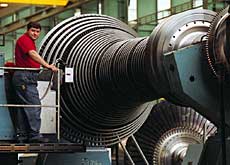Trade surplus reaches four-year high

Switzerland has recorded a SFr7.1 billion ($5.75 billion) trade surplus for the January to September period, the biggest surplus in the past four years.
The Swiss Customs Office said the result was due to favourable global economic conditions and rising domestic demand.
According to customs officials, the chemical, machine and electronics industries were the sectors that benefited most from the improved economic situation.
The trade surplus increased nearly two thirds over the same period last year. While imports were worth SFr98 billion for the first nine months of 2004, exports hovered above the SFr105 billion mark.
Exports
Thomas Trauth, an economist at Credit Suisse First Boston, said the surplus was the continuation of a trend.
“We are still seeing a satisfactory development in trade,” he added. “The surplus is largely due to strong export demand.”
Exports to countries whose economies are in transition, led by China, Russia and Romania, rose by over a quarter compared with the same period last year.
Emerging economies such as Brazil, South Korea, Turkey and Mexico also contributed heavily to increased Swiss exports.
The report said Switzerland’s economy further benefited from the expansion of the European Union – Switzerland’s main trading partner – to include ten new member states.
Older members Spain, Ireland and Britain were also major destinations for a substantial number of Swiss products.
But the remaining EU countries were less enthusiastic about Swiss goods, along with Japan and the United States.
Industrial sectors
All sectors of the Swiss economy benefited from increased exports. Watchmaking, the metalworking industry, food distributors, and the chemical and machine industries made the biggest gains.
The Federation of Swiss Watchmakers said on Thursday it had seen exports increase by 9.5 per cent so far this year, to SFr7.67 billion.
The machine industry did especially well with telecommunications equipment, refrigeration and heating systems, and metalworking machinery.
Pharmaceuticals, vitamins and diagnostic products accounted for one third of the rise of chemical exports.
The clothing, paper and graphics industries recorded smaller increases of exports, while the textile sector saw foreign sales stagnate.
Imports
Imports to Switzerland also rose during the first nine months of the year. Transition economies – mostly China – shipped 17 per cent more goods to Swiss purchasers, double the increase seen from emerging economies.
Among the nations in this second group, Singapore, Turkey and South Korea saw their Swiss exports rise substantially.
The new EU states, especially Poland, outperformed the older members of the Union with an increase of 15.8 per cent in their exports to Switzerland.
Japan, Canada, Italy and Germany also exported more goods than previously to the Swiss market.
swissinfo
Imports increased by 7.2 per cent nominally, but only 6.3 per cent in real terms.
Exports rose 9.7 per cent nominally, but only 5.3 per cent in real terms.
The trade surplus reached SFr7.1 billion for the first nine months of the year, versus SFr4.4 billion for the same period last year.

In compliance with the JTI standards
More: SWI swissinfo.ch certified by the Journalism Trust Initiative











You can find an overview of ongoing debates with our journalists here . Please join us!
If you want to start a conversation about a topic raised in this article or want to report factual errors, email us at english@swissinfo.ch.